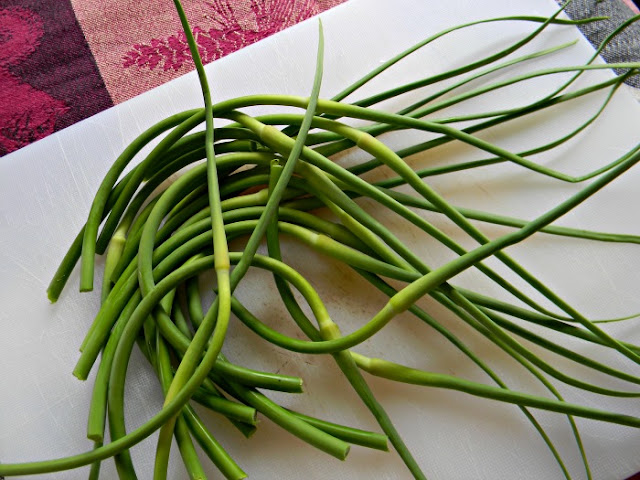The ducks and chickens are giving us so many eggs! This spring's Buff Orpington chicks just began laying today ... one beentsy little egg in the nesting box ~ the size of a large grape ~ tells me that they're coming online. By late November, the newest chicks on the block ~ our surprise batch of bantam babies ~ will be giving us some green eggs to go with our Christmas ham. When a person has chickens (and fowl) and a productive garden, you have to get busy and creative to use up all the goodness coming into the kitchen.
As a big fan of Asian cuisine, one of the recipes I turn to for using up all the bounty is one from Japan. Okonomiyaki are Japanese savory "pancakes" which have an egg base and a few key ingredients which make up the traditional batter. But, from there, the additions can be as varied as you can imagine. It's the perfect recipe for using up extras, leftovers and overloads you may find yourself with. Okonomiyaki literally translates as: "how you like it, grilled/cooked". Perfect!
The beauty of okonomiyaki is that they freeze very well. No worries about making a big batch of one or more variations. Properly packed, the leftover pancakes will wait up to 3 months in your freezer. Flash fry or bake them back to crispness (DON'T microwave them or you'll be eating rubber Frisbees), drizzle with okonomi sauce and maybe some Japanese-style mayo and you have an almost instant (and fairly healthy) meal! Give it a try and have fun with it.
** Using dashi is best, but you can use just plain water, too. Napa cabbage and green onions are in every recipe, but the rest of the additions are up to you! Dashi and Okonomi sauce are available at Asian groceries and some grocery stores.
OKONOMIYAKI
Basic Batter:
6 large eggs
1 ½ c. cold water
1 packet Dashi powder or granules (Japanese soup
stock)
2 c. flour
1
t. salt
In
large mixing bowl, combine cold water and dashi powder and whisk to mix. You
can also just use plain water or cold vegetable stock. Add eggs and salt,
whisking to completely combine. Add flour and whisk until nearly smooth. Let
batter rest while you prepare your pancake additions.
1 ½ c. shredded napa cabbage
1/3 c. chopped green onions
__________
Shredded zucchini
Fresh or frozen peas (thawed)
Finely shredded carrot
Roasted red pepper
Shredded daikon radish
Fresh shiitake mushrooms
Sliced kamaboku (fish cake)
Shredded daikon radish
Fresh shiitake mushrooms
Sliced kamaboku (fish cake)
Bay scallops
Cooked chicken or pork,
chopped
Smoked salmon
Cheese
Salad shrimp or chopped
prawns
** All okonomiyaki have
shredded cabbage in them. All the other additions are your choice. Okonomiyaki
literally translates as : cooked as you like it! Just remember that, whatever
your ingredients, they must be in small enough pieces to cook thoroughly in the
short time it takes to make the pancake. Do not use uncooked meats or fish
unless they are very small pieces, such as the small scallops or pieces of
small, raw shrimp.
Peanut oil is recommended for
frying – it gives a nice crust and is a lighter oil so the pancakes don’t
become heavy or saturated with oil.
Serve hot, drizzled with Okonomi sauce. Popular additional toppings are Japanese mayonnaise +/- hot chili paste.
Makes 8-12 pancakes



















